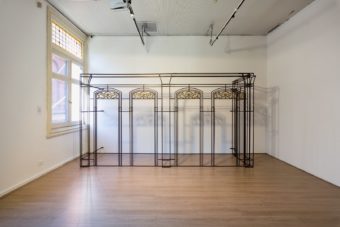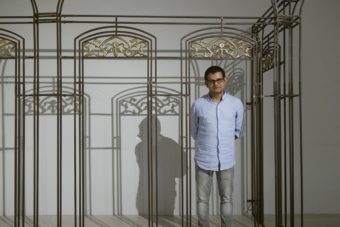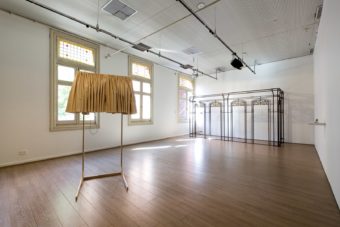Rathin Barman is a Kolkata-based artist, whose recent installation works reflect socio-political issues and histories through architectural forms and urban landscapes. Trained as an engineer and sculptor, Barman’s work often explores the consequences of political upheaval through the form of architecture and built environments.
Commissioned by the Singapore Biennale 2016, Barman’s Home, and a home (2016) takes the exterior of a colonial shop-front in Little India, Singapore, as its aesthetic and socio-political referent. The social and political histories of buildings such as this becomes central to Barman’s work, whilst suggesting possible futures for the buildings, and the migrants that build and dwell in them.
What processes or research informed your creation of Home, and a home?
Home, and a Home emerges from several conversations over many days with Bangladeshi migrant workers based in Singapore. I was introduced to a few of them by Mr. Mohsin, Chief Editor of Banglar Kantha, a Bengali newspaper published in Singapore with contributions from the workers amongst others. Mr. Mohsin has offered his office space to the workers so that they can perform music, recite poetries written by themselves in the evening after their day jobs. The research was mostly interactive, involving conversations around their homeland of Bangladesh, homes (dormitories) they live in Singapore, their work situation, and how and what brought them to Singapore. There are groups of people I met randomly on the road and restaurants everyday during my stay in Singapore, who revealed to me their various journeys from home to other homes.

Can you describe the relationship between architectural space and memory in this work?
Architectural spaces often become the prime visual in my work. By this I mean not just the existing architecture, but also collective or personal memories of architectural space/s that have been conceptually reconstructed as sculptural installations. And a home always become a home with memories associated with it, which one generation transports their memories to another to create history associated with a particular space. In this work the notion of a living space has been represented through a simulated architectural outfit. The experience of lived space and memory arises when the viewers walk inside the installation.
Do you think that the medium of installation in this work allows for a deeper understanding of the complex entanglement of built environments and layered social and cultural histories, through movement and relationship to the space?
Yes, indeed the materials used for the project are significant to the lives of the workers. Two major sculptures for the project are three-dimensional drawings of architectural spaces which simulate the spaces shared by the workers who live in Little India in Singapore. I also used materials such as concrete and rebar to make sculptures conceptually derived from the idea of homes the migrant workers dreamt of existing in, in their home country. This signifies socio-economic position too.
“In my installation, you see both the beautiful shop-house front, and in it, a cage-like space in between. Viewers are allowed to walk inside the installation, but the experience of walking into the space in essence symbolises the poor living facilities of the workers.”
Migrant labourers inhabit a fraught space in Singapore. They at once play a vital part in the ongoing creation of the nation’s infrastructure, whilst their conditions, and contributions to Singapore perhaps go unnoticed to the unseeing eye. Can you speak to this interplay of visibility and invisibility in your work?
Politically the situation related to migrant workers remains unnoticed for the most part, which I reflect upon in the By All Estimates exhibition at 4A. The freestanding brass and steel installation Home, and a Home is again a simulation of a particular shop-house that is a temporary home for 52 workers who are legally fighting with their employer without having any legal work permit in Singapore, with no compensation or stipend. However, they have been involved in working for some companies who illegally pay below minimum wage. They have been literally crammed and caged to survive, which of course is rendered invisible from the surface of the beautiful colonial building. In my installation, you see both the beautiful shop-house front, and in it, a cage-like space in between. Viewers are allowed to walk inside the installation, but the experience of walking into the space in essence symbolises the poor living facilities of the workers.

In what ways do you see Singapore’s colonial history of indentured labour relating to the present situation of migrant workers?
During the colonial era a huge number of Indians were displaced to Singapore, and following this, many Bangladeshi workers began migrating to Singapore in significant numbers in search of work during the Gulf War in the 90’s. Singapore utilises this influx of migrant workers as human resources to build infrastructure of the country. But the situation of the migrant workers, especially in the case of majority of Bangladeshi’s has not changed a great deal.
On the contrary, getting work abroad for Bangladeshi workers is very competitive. There are many processes that must be fulfilled by the workers before being granted a work permit. The establishments involved in granting such work rights demand very large amounts of money from the workers for their permit. In light of this, the workers loan money from informal sources with high interest rates, or are forced to sell their possessions such as land or jewelry to get the job. Once you are in this situation, you have no option to look back, but must work and earn whatever you can to repay your loan back. It is needless to mention that often workers hailing from villages and rural areas are most likely to get cheated.

You developed this work for Singapore Biennale in 2016, and are now exhibiting your work in Australia for the first time alongside artists with multiple connections to Singapore. Has engaging with differing inter-Asia perspectives in By All Estimates offered new outlooks for you in relation to Singapore, or perhaps to your practice?
To my practice, of course yes. The experiences I am having in this visit has definitely added new perspectives to the work. Bringing the sculpture as an idea to a new space, in a different country itself is creating a new layer of context to the work.
Are you working on any new projects currently? What can we expect to see from you in the future?
RB: I recently had a solo exhibition at Experimenter Kolkata, The Thinking Forest is not a Metaphor, about how people and homes grow together in quite a unique way. The show reveals complex relationships between space and its’ occupants through drawings, sculptures and sculpture-based installations. It is an ongoing project I am working on now.
By All Estimates exhibition is showing at 4A Centre for Contemporary Asian Art (Sydney) between 12 April – 26 May, featuring artists Rathin Barman, Jessica Bradford, Erika Tan and Moses Tan.
Taking Singapore as a locus of multiple regional identities, By All Estimates brings together works by artists that give form to narratives obscured by the city-state’s rapid urban and social development and the coexistence of competing projections of cultural inheritance and recognition.

